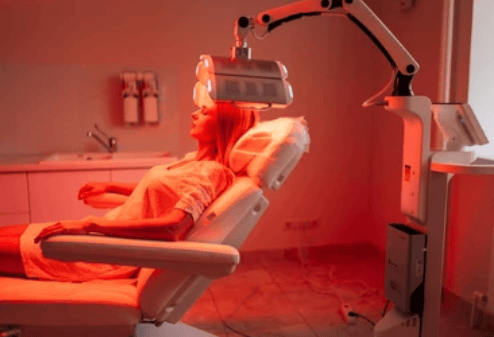Infrared saunas and red light therapy are everywhere in wellness circles right now. From spas and gyms to home setups, both treatments are gaining serious attention. But while they may look similar—think glowing panels and warm light—their goals, mechanisms, and benefits are quite different.
So which one is right for you?
That depends on what you’re looking for. Infrared sauna therapy focuses on deep, full-body heat for detoxification, relaxation, and cardiovascular support. On the other hand, red light therapy uses specific wavelengths of light to target cells and promote healing, skin rejuvenation, and reduced inflammation.
In this guide, we’ll break down infrared sauna vs red light therapy. You’ll learn how each treatment works, what the research says, and how to choose based on your wellness goals. Whether you’re aiming to recover faster, sleep better, or boost your skin health, understanding the difference is key.
Let’s get clear on the science, benefits, and best uses of these two popular tools.
What Is Red Light Therapy?

Red light therapy (RLT) is a non-invasive treatment that uses low-level red and near-infrared light to support healing and cellular health. Also called photobiomodulation, this therapy delivers light wavelengths between 630 and 850 nanometers directly to your skin and tissues.
But how does it work?
The light penetrates the skin and reaches cells. Once absorbed, it helps stimulate mitochondria, the energy centers of your cells. This boosts ATP production—the energy your body uses for repair, growth, and regeneration.
That extra cellular energy supports a wide range of benefits. People use red light therapy for:
- Collagen production (smoother, firmer skin)
- Pain relief (especially joint or muscle pain)
- Wound healing and tissue repair
- Reduced inflammation
It’s often used on the face, back, or joints, and sessions usually last 10–20 minutes. Most treatments are painless and don’t generate heat, unlike saunas.
Clinical research continues to grow, especially in dermatology and sports medicine. Results vary, but many users report noticeable improvements after a few weeks of consistent use.
In short, red light therapy helps your body heal and perform better—from the inside out.
>>Related: Red Light Therapy at Home: Benefits, Devices & Best Practices
What Is an Infrared Sauna?
Unlike traditional saunas that heat the air around you, infrared sauna therapy uses infrared light to warm your body directly. This type of heat penetrates deeper into the skin and muscles, creating a gentle but intense warming effect from the inside out.
You feel warm, but the air stays cooler—making it easier to tolerate longer sessions.
Infrared heat promotes sweating, which many people associate with detoxification. It helps your body flush out impurities through the skin while boosting circulation, easing muscle tension, and encouraging deep relaxation.
Many users turn to infrared saunas for:
- Workout recovery and muscle soreness
- Chronic pain or joint stiffness
- Lowering stress and cortisol levels
- Improving sleep and cardiovascular health
Studies suggest regular sessions can support heart health by mimicking the effects of moderate exercise—raising your heart rate and improving blood flow.
Sessions typically last 20–45 minutes. You sit or lie in a wooden cabin surrounded by infrared panels, often with calming music or chromotherapy lights.
In short, infrared sauna therapy offers a full-body wellness reset that relaxes the mind and recharges the body—without the extreme heat of traditional saunas.
Key Differences Between Infrared Sauna and Red Light Therapy
Infrared saunas and red light therapy may look similar—both involve light panels and promise wellness benefits—but they work in very different ways. Understanding these differences helps you choose the right one for your goals.
Here’s a side-by-side breakdown:
| Feature | Infrared Sauna | Red Light Therapy |
|---|---|---|
| Primary Function | Detoxification, stress relief | Cellular healing, regeneration |
| Heat Level | High—induces sweating | Low to none—light without significant heat |
| Light Wavelength | Mid to far infrared (heat-producing) | Red + near-infrared (non-thermal, healing) |
| Treatment Duration | 20–45 minutes | 10–20 minutes |
| Applications | Circulation, recovery, relaxation | Skin health, pain relief, athletic performance |
| Contraindications | Not ideal for heart or heat sensitivity | Caution for photosensitive users; protect eyes |
Let’s unpack a few of those.
Heat vs. Light
Infrared saunas work through heat. The infrared rays penetrate the body, raising core temperature and promoting sweat. This supports detox, cardiovascular health, and mental relaxation.
Red light therapy, by contrast, uses light at specific wavelengths to stimulate cellular energy (ATP). It doesn’t heat the body much but instead works on a cellular level to improve tissue repair, inflammation, and collagen production.
Use Cases
Use an infrared sauna when you want a full-body reset—like after a tough workout or stressful day. It’s ideal for sweating, relaxation, and recovery.
Choose red light therapy when you want to target specific issues—like fine lines, joint pain, or muscle fatigue—without the heat or long sessions.
Safety Notes
If you have heart issues or are prone to overheating, stick with shorter or milder sauna sessions—or consult a doctor first.
If you’re using red light therapy, avoid looking directly at the light, especially without eye protection. Those with light sensitivity should proceed with caution.
Red light therapy vs infrared sauna isn’t about which one is better—it’s about which one supports your wellness goals best. You may even find that using both creates a perfect balance between recovery and rejuvenation.
Which One Should You Choose?
Still wondering which is better—red light or infrared sauna? The answer depends on what your body needs most right now.
If you’re looking for deep relaxation, detoxification, and cardiovascular support, go with an infrared sauna. The heat helps your body sweat out toxins, improves blood flow, and mimics the heart-healthy effects of light exercise. It’s a great option for stress relief and post-workout recovery.
But if your focus is on anti-aging, skin repair, or muscle healing, red light therapy is the better match. It works on a cellular level, stimulating collagen, reducing inflammation, and accelerating tissue repair. It’s also ideal for those who can’t tolerate high heat.
Here’s the good news: you don’t have to choose just one.
Many wellness experts recommend using both. You can enjoy an infrared sauna session to relax and release tension, followed by targeted red light therapy to support skin health or sore joints. They work through different mechanisms and offer complementary benefits.
Start by identifying your goals—then match your therapy accordingly. Or rotate both into your weekly wellness routine for maximum results.
Either way, you’re making a smart move toward better recovery, balance, and long-term well-being.
Safety & Best Practices
Both infrared saunas and red light therapy are generally safe when used properly—but smart use matters.
For infrared sauna sessions, always stay hydrated. Drink water before, during, and after your session to replace lost fluids. Start with shorter sessions—around 15–20 minutes—especially if you’re new or heat-sensitive. Make sure the room is well-ventilated, and never push through if you feel lightheaded or dizzy.
Red light therapy safety starts with your eyes and skin. Don’t stare directly at the light source. Use eye protection (many devices include goggles), especially when treating the face. Stick to recommended exposure times—usually 10–20 minutes per area—and avoid cranking the settings too high.
Also important: don’t overdo it. More isn’t always better. Follow your device or sauna manufacturer’s instructions closely. Most benefits come with regular, moderate use, not marathon sessions.
If you have a medical condition, are pregnant, or take medications that cause photosensitivity, check with a healthcare provider before starting either therapy.
When used mindfully, these tools can boost your wellness safely and effectively. Just listen to your body—and the science.
FAQs: Infrared vs Red Light Therapy
Can I use red light therapy and an infrared sauna together?
Yes, absolutely. These therapies work in different ways, so they’re safe and often more effective when combined. Many people use a sauna for detox and relaxation, then follow with red light therapy to support skin health or muscle recovery.
Is red light therapy hot like an infrared sauna?
No. Red light therapy uses low-level wavelengths and produces minimal to no heat. It doesn’t raise your core temperature or cause sweating. It’s gentle on the skin and great for those who are sensitive to heat.
How often should I use each therapy?
For infrared saunas, 2–4 sessions per week is typical. Start slow and increase as tolerated. For red light therapy, most users benefit from 3–5 sessions per week, depending on the device and treatment area. Always follow the manufacturer’s instructions.
Which therapy is better for weight loss or inflammation?
Infrared saunas may help with calorie burn and water weight loss, while red light therapy targets cellular inflammation and recovery. For reducing inflammation, red light therapy may have more direct effects. But for overall detox and circulation, infrared saunas are highly effective. You can use both for a well-rounded approach.
Conclusion
Both infrared sauna and red light therapy offer powerful but distinct wellness benefits. One focuses on heat and detox, while the other works through light and cellular healing.
Knowing the difference between infrared sauna and red light therapy helps you choose what fits your goals—whether it’s stress relief, skin repair, or inflammation recovery.
The good news? You don’t have to pick just one. Many people find the best results by combining both therapies in a weekly routine.
Just be sure to follow safety guidelines, listen to your body, and consult a healthcare provider if you have medical concerns.
With the right approach, these modern therapies can help you feel more energized, relaxed, and resilient—naturally.
